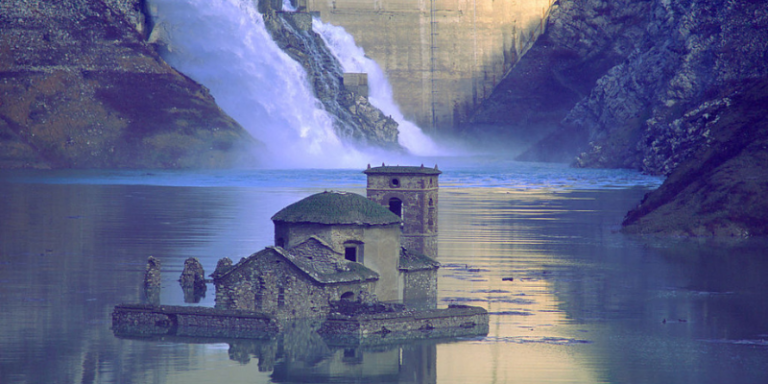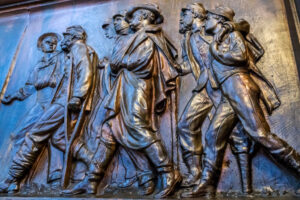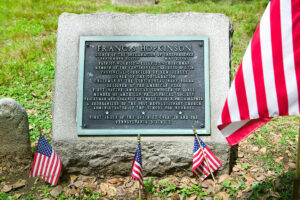The Spill: A Modern Atlantis
Weekly news you can use.
By: GenZ Staff | June 17, 2020 | 969 Words

Fabbriche di Careggine (Photo by Romano CagnoniGetty Images)
Italy’s Modern Atlantis
The legend of Atlantis, the mythical island that sank into the ocean around 9,600 B.C., has some competition from a real-life “ghost town” in Italy. Fabbriche di Careggine, a 12th-century town, may appear next year from the bottom of a lake in Italy, where it was flooded to build a dam and create a manmade lake to fuel hydroelectric energy in 1946.
The village was home to around 150 residents but they were relocated to a different area so the dam could be built. It had 31 stone houses, a cemetery, and a three-arched bridge. The Romanesque Church of San Teodoro was the tallest part of the town, because of its bell tower.
The village had been around for about 800 years when it was flooded. The medieval town was a place for artisan blacksmiths to practice and work their trade. Progress has a way of changing things, and so, in 1946, the citizens were moved to Vagli Sotto, which was built to look exactly like the home they were leaving.

It’s been 75 years since Fabbbriche de Careggine went to the bottom of the lake, but four times it has resurfaced when the lake was drained for dam maintenance. The most recent was in 1994 when around one million people flocked to the area to walk among the sunken treasure. It looks like there will be another opportunity in 2021 to see the rise of the ancient city as plans are being discussed to drain Lake Vagli to perform maintenance on the dam.
Last Civil War Pensioner Passes Away
Irene Triplett saw a lot of things during her 90 years of life, but one truly memorable fact was that her father fought in the Civil War. She was the last American to receive a Civil War pension until she passed away on May 31. Suffering from mental disabilities, Irene was able to collect support as a “helpless adult child of a veteran.” A monthly check for $73.13 from the Department of Veteran Affairs paid for some of her expenses.
Dennis St Andrew, a commander of the North Carolina Sons of Union Veterans of the Civil War, said Triplett was “a part of history.” Most people today wouldn’t expect to meet someone so connected to the historical conflict, but “You’re talking to somebody whose father was in the Civil War,” he said. “Which is mind-bending.”

National Building Museum, Pension Building, frieze depicting Civil War soldiers. (Photo by: Jeffrey Greenberg/Universal Images Group via Getty Images)
When Irene was born, her father, Mose Triplett, was 83 years old. She was raised poor in North Carolina and left school in the sixth grade, never learning to read or write. As she grew up, she was teased because her father served in both the Confederate and Union armies and was called a “traitor” for fighting for the North.
Mose was only 16 when he enlisted with the Confederate North Carolina Infantry Regiment in 1862. In 1864, during the Battle of Gettysburg where his battalion suffered horrific losses (734 of the 800 men were killed, wounded, or captured), the young soldier made a daring escape and enlisted with the Union. He was 21 years old at the time.
He joined the 3rd North Carolina Mounted Infantry, a Union regiment. The group was known as Kirk’s Raiders, and it was their mission to sabotage Confederate targets in eastern Tennessee and western North Carolina.
Mose was feared and despised when he returned from the war, considered a deserter and a traitor. Neighbors were afraid of him because he kept pet rattlesnakes and sat on his front porch with a pistol on his lap.
Mose passed away on July 18, 1938, at the age of 92.
America Celebrates Flag Day
On June 14, 2020, the United States Flag turned 243 years old, and the American president, Donald Trump, celebrated turning 74 on the same day.
During the Revolutionary War, the Continental Army flew several different flags, ranging from those of individual colonies to the Grand Union flag. General George Washington felt something needed to be done to rally the troops, and the Second Continental Army agreed. On June 14, 1777, the new flag was adopted.

Gravestone for Francis Hopkinson (Photo by: Joe Sohm/Visions of America/Universal Images Group via Getty Images)
Betsy Ross has been credited with creating the flag, but that has not been proven. Legend claims that Washington asked the seamstress to design the banner, but scholars give the recognition to Francis Hopkinson, who helped create the first coin of the U.S. and the Great Seal.
The flag has changed throughout the past centuries and there have been 27 official versions, each with a different arrangement of the stars. In 1912, President William Howard Taft arranged the flag’s 48 stars into six rows of eight, and in 1916, President Woodrow Wilson declared June 14 a national holiday called Flag Day. President Harry Truman signed it into law in 1949. Two more stars have been added since then to represent the last states to join the Union: Alaska and Hawaii.
Alaska was set to become part of the United States in the 1950s and people were scrambling to come up with a fresh new design for the stars. Bob Heft, a 17-year-old student from Ohio, stitched 50 stars onto a pattern for a class project, using his mother’s sewing machine. Hawaii had not committed to joining yet, but the young man was sure it would, which is why he put 50 instead of 49 stars onto the material. He received a B from his teacher.
Heft wasn’t deterred; he sent his design to his congressman, who presented it to President Dwight D. Eisenhower. On July 4, 1960, Heft stood next to the president as his design of 50 stars was raised in the nation’s capital. For his effort, the teacher changed his grade to an A+.
















